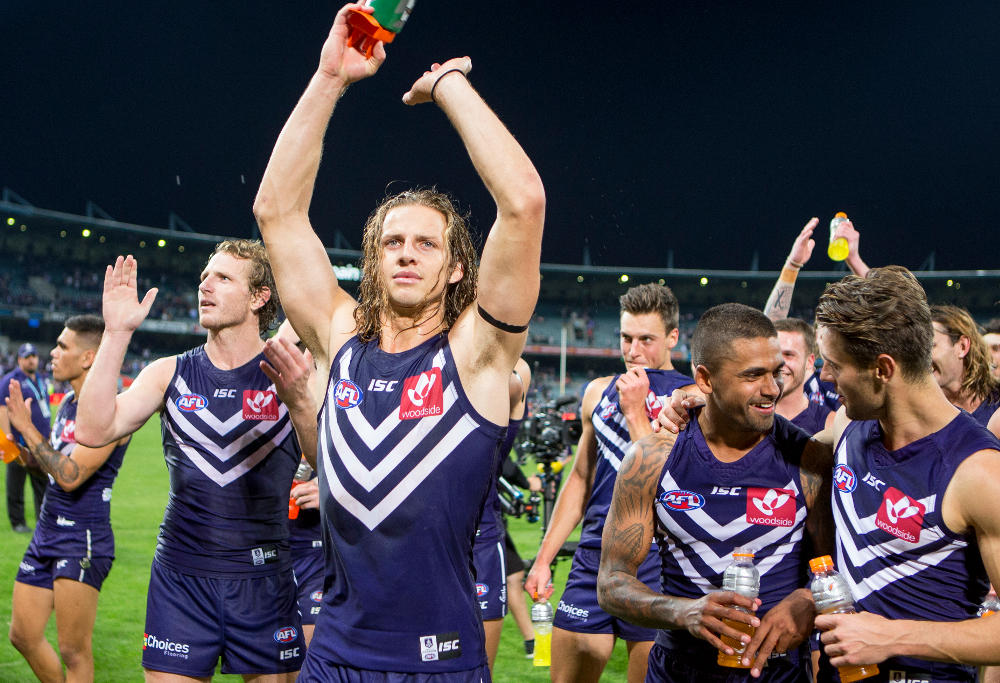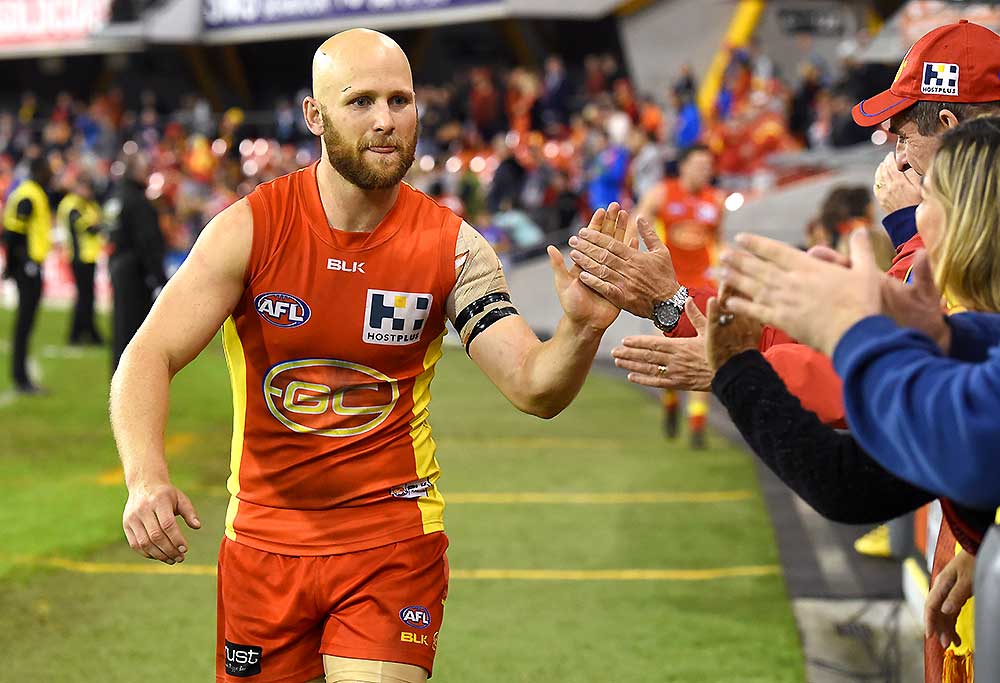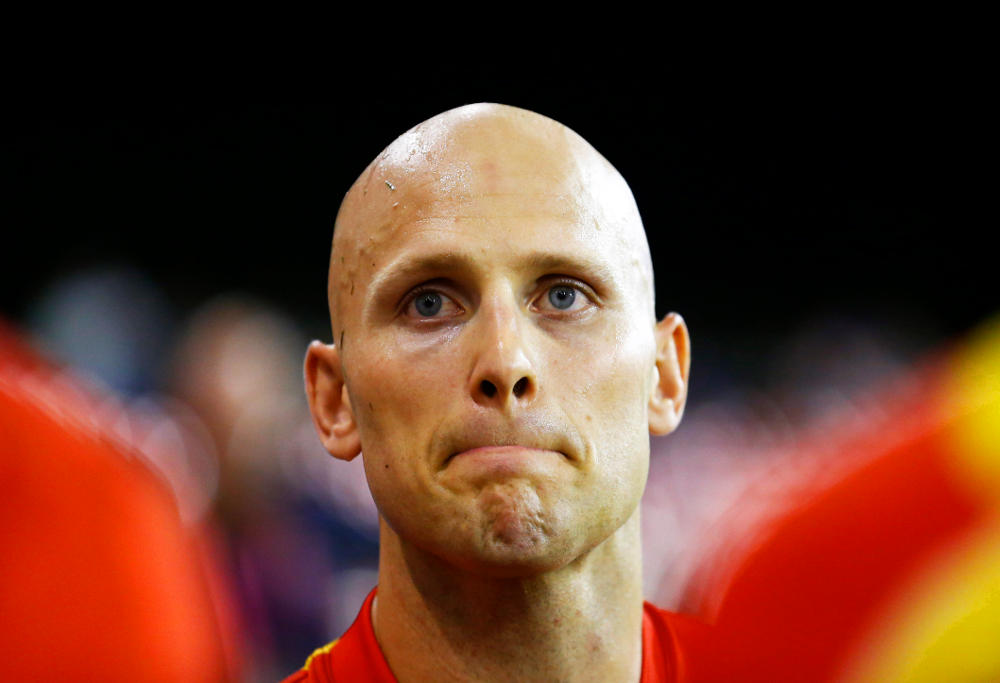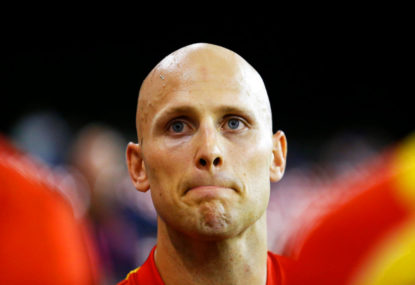Football folklore says Gary Ablett Junior’s 2017 season should not be possible.
He’s 33 years old, returning from a serious shoulder injury, with rampant off field speculation hanging over him. It’s the latest act in a Hall of Fame career, that could see him reclaim the crown everyone thought had moved beyond his grasp.
Less than six weeks ago, Ablett’s form was the subject of rampant, idle and frankly ridiculous speculation. “He’s playing like his heart just isn’t in it anymore” was the common refrain. Ablett felt compelled to go on the colossus of intelligent football conversation that is Channel Nine’s The Footy Show to bat away five minutes of inane questioning about his football future, such was the height of the madness.
How quickly things change. Ablett has not only recaptured his best form from before his shoulder injury – he’s made it look a little more human than we thought. The Gold Coast Suns have reeled off two excellent home wins in May and the first week of June, a period that saw them travel from the Gold Coast to China to Alice Springs and back to the Gold Coast.
There’s plenty wrong off the field at Metricon Stadium, as we were reminded earlier in the week when Jarrod Harbrow was caught drink driving and Jack Martin found himself in a bad situation on a night out. Vice captain Steven May is subject to weekly speculation about a move in the off season, as is Ablett, who marked his cards clearly before the year got underway.

(AAP Image/Julian Smith)
But on the field, well, there are issues but at least the Suns looks competent for large patches in games. Ablett’s return to league-best form is central to this.
Gary Ablett Junior is not the best player in the competition. He hasn’t been since the tail end of 2014, when a league-shaking tackle laid by Brent Macaffer separated his shoulder and sent him to the football wilderness for the better part of two and a half years. That he’s playing at all given the circumstances is worth admiring.
Who is the best player right here, right now
But if it’s not Ablett, who held the title for half a decade, who is the best player? If we play the AFL punditry’s favourite game for 2017 – What Have You Done For Us Lately – it’s probably Josh Kelly, who played one of the best individual games of the past few years against the Dons on the weekend.
Patrick Dangerfield has moved into outright favourite for the Brownlow medal in recent weeks, as his portfolio continues to shift from forward progress maker to actual finisher. Dangerfield hit the half way mark of the season four disposals short of averaging 30 touches and two goals a game, while simultaneously lifting his tackling, contested possession win and clearance rates to fresh career highs.
Hmmm. Patrick Dangerfield is probably the best player in the competition.
Dustin Martin is having a similarly stellar year, his ground ball winning and long kicking particularly brilliant for a man many thought would top out as a bullocking stoppage specialist. Martin still makes odd decisions at times, but we can’t rule out that it’s because he sees the world through the lens of what’s possible, not what’s probable.
Rory Sloane’s scorching start has given way to a more moderate temperature in recent weeks. Still, his unique centre-back style – Sloane rarely spends time as a forward, instead working the middle of the ground and helping on defence – and ball-winning prowess make him the most influential player on an 8-3 team.
Lance Franklin continues to live up to his lofty standards, and is one of three players to have kicked more than three goals a game. His long goals remain the stuff that football dreams are made of. Franklin’s arch nemesis, Alex Rance, has worked his way into a stellar patch of form in recent weeks. His power to control the force remains as strong as ever, with Rance getting his Jedi on with increased frequency.
Captains Joel Selwood and Scott Pendlebury continue to dazzle with their contrasting stylings. Selwood continues to find new ways to extract blood from parts of his head, while Pendlebury is still yet to make a bad decision this season.
A forgotten man in this debate seems to be Nat Fyfe, who hasn’t captured his planet-smashing form from before his leg was surgically repaired twice in less than six months. This is where the WHYDFUL crowd is really getting their kicks this season.
Fyfe’s season has been great. He is one of ten players to average 25 disposals, 12 contested possessions, five clearances and seven score involvements per game. The other members of that made up list are above (Dangerfield, Martin, Sloane, Selwood, Pendlebury), plus Taylor Adams, Adam Treloar – just quietly, Collingwood’s midfield trio are playing out of their minds through 11 games – Ollie Wines (who has joined the ranks of the uber elite footballers, you just don’t know it yet), Ablett and Fyfe.
Yet, everything you read about Nat Fyfe is how disappointing he’s been. What have you done for us lately, Nat? But I digress. Gary Ablett has also joined in on the action, putting together a season for the ages at a time in his football career that history says isn’t possible.

(AAP Image/Travis Anderson)
The King returns from exile
At the start of the 2016 season, we talked about Ablett’s return from his season-interrupting-cum-season-ending shoulder injury. The team he left, which was building nicely around him, has stuttered its way through 2015, off field issues plaguing the second newest club in the competition. Our material interest was Ablett himself though, and the fact that history was stacked against him playing any volume of football.
As a reminder, missing big chunks of football after the age of 30 is normally terminal for an AFL career. Of the 30 players that missed at least 22 games over a two year stretch after turning 30 – for any reason, not just injury – 22 never played again. Seven played less than 20 games over the remainder of their career. Only one continued along a linear trajectory into their 30s: Robert Harvey. It’s still relatively early, but Ablett looks set to join Harvey in the post-30 club.
Ablett is revelling in the improvement to Gold Coast’s midfield created by the insertion of a few mature aged players. He is no longer the only reliable ball winner running through the middle of the ground, and as a result gets a little bit less attention from opposition midfielders. Not that Ablett was ever fazed by an accountable match up.
A fellow football geek remarked earlier this week that in many ways the Gold Coast Suns are out of sight and out of mind this season. Their fixture has seen them play many games in timeslots where there are more than one game on at any time; expectations coming into the year were quite low, meaning it was always going to be a challenge getting people to tune in. I’ve not seen as much of the Suns as I would like, but enough to notice some stuff.
Jarryd Lyons, Michael Barlow and the development of Touk Miller means Gold Coast is developing depth through its midfield that just wasn’t there prior to Ablett’s exile. Lyons’ role as distributor in chief is particularly helpful for Ablett, who no longer needs to spend a chunk of his game time making up for the young, inexperienced bodies of his team mates at stoppages or through the centre.
The Suns are still a middling midfield team, recording an adjusted contested possession differential (contested possessions less free kicks and contested marks) of +0.5 on the year and an inside 50 differential of -1.6 per game (both ranked 10th). Their team-wide kick-to-handball ratio of 1.09 suggests they are looking to create overlap run and carry, rather than playing the more kick-mark oriented game of many of the other lower sides. It’s a bold strategy, and one that looks to have resulted in some challenges down the defensive end of the ground.
Gold Coast have been able to score at a decent clip, but their defence has kept them out of games. The Suns concede 106.1 points per game, second only to the Brisbane Lions (122.2 points per game). Their penchant for running in waves leaves their back six exposed, leading opponents to score relatively easy – the Suns are conceding 2.14 points per minute of opposition possession, 18 per cent above the league average, and only a hair lower than the league-leading Adelaide Crows are scoring at.
Gold Coast are the second worst team at conceding scores from turnovers, allowing opponents to put up 69 points per game (ranked 17th behind you-know-who).
This is important, if only because we’re talking about Ablett today, and the chance he may have of winning a third Brownlow medal.
Three’s company
Four players in VFL/AFL history have won three Brownlow medals: Haydn Bunton Senior, Dick Reynolds, Bob Skilton and Ian Stewart. Stewart is the only player to do it and win one of his medals at a second club (St Kilda, then Richmond). All four are certified legends in the Australian football hall of fame.
Ablett has a small but not insignificant chance of joining this illustrious club of three-time Brownlow medallists in 2017.
Remarkably, Ablett is currently averaging more disposals, more tackles, more inside 50s and more clearances than his 2013 Brownlow medal-winning year. He’s down on contested possessions, but up on uncontested possessions; down on goals and scoring shots, but is averaging a direct goal assist per game (up from 0.8 goal assists in 2013).
|
2009 |
2013 |
2017 |
| Disposals |
33.82 |
31.19 |
32.11 |
| Goals |
1.23 |
1.33 |
0.67 |
| Assists |
0.73 |
0.81 |
1 |
| Tackles |
4.18 |
4.57 |
5.22 |
| Clearances |
4.86 |
5.9 |
7.11 |
| Contested Possessions |
13.41 |
14.9 |
12.56 |
| Inside 50s |
3.59 |
5.38 |
6.56 |
| Brownlow |
Yes |
Yes |
? |
Season-long counting statistics don’t matter a whole lot for individual awards. They might be revealing after the fact, but if we’re trying to forecast it’s better to get granular. Indeed, there are plenty of professional bettors who pore over game by game box scores to build models that help them predict all manner of Brownlow-related bets.

(AAP Image/Dave Hunt)
In his time at the Suns, history shows Ablett has polled well in games where he has personally had 30 disposals and kicked multiple goals, and when his team has won. In 2013, there was only one game in which Ablett had more than 30 touches, kicked more than one goal, and that he team won in which he didn’t catch three votes from the umpires. Charlie Dixon kicked six goals to snare the triple, while Zac Smith had 21 hit outs and kicked three himself to win two.
Ablett had to up the ante to win three votes for his efforts in 2009 when he was playing for the Cats. In his eight three vote games, Ablett had at least 35 disposals and 12 contested possessions, and in all but two kicked a goal for himself. That was the time before 30 disposal games were a dime a dozen (only two players cracked the 30 touch average in 2009 – 12 sit above that precipice in 2017).
He’s been down on goals, but otherwise, Ablett’s form to date in 2017 suggests he will be well and truly in the votes in the first half of the season. Ablett has delivered six games of 30+ possessions, four of those with a goal or two attached and a fifth where he directly assisted in two others.
Again, let’s just sit back and marvel at this for a minute. Ablett turned 34 in May, and is not only set to break an otherwise hard and fast AFL rule about players playing into their 30s after season-ending injuries, but he’s balling like very few players can.
The critical ingredient to Brownlow medal wins is team wins. Last season, 178 of a possible 198 three vote games went to a player on the winning team. The effect is less extreme as we work our way down the vote tally: 161 of a possible 198 two vote games went the way of the W, as did 149 of a possible 198 one vote games. It was a similar share in 2007, albeit the share of two and one vote games going the way of the winners has increased over the past decade.
That’s important. Ablett won the 2013 Brownlow medal with his team finishing on 8-14 with a percentage of 91.7 per cent. He was on track to repeat in 2014, albeit this time with a team record of 9-6 in the games he played. Winning will probably be an important factor in Ablett’s potential vote tally this season.
Four of Ablett’s 30+ disposal performances came in victories, and a fifth – probably his best game for the year – came in a 13 point loss to the uninspiring North Melbourne. In that game, Ablett had 45 disposals, 18 clearances (not a typo), 27 contested possessions (also not a typo), just three clangers that weren’t free kicks against, kicked one goal one behind and directly assisted on four other Suns scores.
His advanced stats are just as gaudy: 14 score involvements and 618 metres gained. North’s Ben Brown kicked six goals, but Ablett’s masterclass will win him three votes.
Based on history, that could be five three vote performances in the first half of the year. It probably won’t be of course (Ablett is rated as a reasonably long outsider on the markets right now), but it could be, and that’s sort of the point. A player who was written off by many after two sluggish starts has regained the sparkle that has made him one of the modern league’s most revered figures.

(AAP Image/Jason O’Brien)
Does his form complicate the formality of his move back to Geelong at the end of this season? Perhaps, given the talk at the end of last year was Ablett was to return to his roots as a wily forward pocket as he saw out the rest of his career down south.
Not now, not in the form that he has displayed. There is plenty of time to talk about market value for players; it isn’t now, least of which because the rules of the game in the form of a new Collective Bargaining Agreement remain hilariously and somewhat concerningly up in the air.
But more than that, we should be thinking about the here and now, and Gary Ablett’s remarkable return to an apex he shouldn’t have reached. We should revel in it, celebrate it, and use it as a timely reminder next time we want to write a player off that the best in class reach the pinnacle of their power for a reason.

































































































